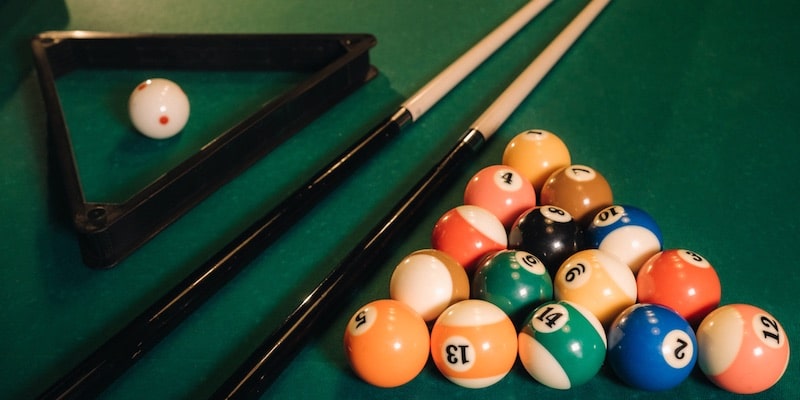We explain what billiards is, its basic rules and elements it uses. In addition, we tell you what variants of this sport exist.

What is billiards?
billiards It is a sport that is played by propelling a set of numbered balls on a cloth-covered table using for this a wooden block with a blunt tip. It is considered a precision sport, as it requires precise calculations to predict the direction of the hit ball.
In a strict sense, billiards consists of a range of similar games, which share the basic dynamics of the cue and the balls on the table but which differ in their rules and fundamental tasks. Thus, in some cases the table has holes with pockets to insert the balls, while in others the table is uniform and the game consists of making caroms, that is, combinations of blows and movements of the balls.
The name billiards comes from French billiardsa word used to name the taco and which comes from medieval Latin billa (“tree trunk”). It is also stated that the term could come from French billewhich translates as “marble” or “small ball.” Despite the Gallic origin of its name, billiards does not have a clearly defined origin: its invention is attributed to different countries, such as France, England, Italy, Spain and even China.
See also: Types of sport
history of billiards

Although there is evidence of previous sports of very similar logic, which were played on the ground, The first known references to billiards date back to medieval Europe in the 15th century: During the rule of Louis XI in France, court cabinetmaker Henry Devigne devised a way to practice this sport on rainy days.
This is how the first pool table was designed, which used balls made of ivory on a marble surface covered by a green cloth. Instead of contemporary cues, others similar to golf clubs were used, made of ash wood and ivory heel.
billiards It was an elite sport, practiced by royalty almost exclusively and to which doctors of the time associated different beneficial effects. The common people did not begin to practice it until the time of the French Revolution of 1789, and from then on it spread throughout France and Europe, acquiring new practices and modalities along the way.
Basic rules of billiards

Although the rules of billiards can vary substantially from one variant of the game to another, there are some fundamental instructions, such as:
- Can be played individually or in groups that is, two players in mutual competition, or two teams of up to two players. Although it is also possible to play it alone.
- The game is played in turns. During a player's turn the others must give up the table and not hinder the play in any way. In all cases, the action must take place on the table, and if the ball escapes from it, it will be considered a foul.
- The games do not have a specific duration, but end when one of the two competitors defeats the other. This can happen because he reaches a pre-established score, because he inserts all the balls that correspond to him in his pockets, or because his opponent makes a serious mistake that costs him the game.
- The balls cannot be hit directly with the cue, but rather through the cue ball (which has no numbers or reasons), either directly or through the bounce on the edges of the table.
- Failure to hit the cue ball, or to hit it improperly with the cue, constitutes a foul and normally causes the game turn to be lost and the opponent can freely decide the location of the cue ball for his next shot.
Variants of billiards

Billiards is, in reality, a set of games, which differ from each other in numerous details and senses. Many of them can be played on the same table, while others require certain variations, such as pockets in the corners. The best-known variants of billiards are the following:
- French billiards or caroms. French billiards is played on a table without pockets, using only three balls (one red and two white). The purpose of the game is for each player to hit the ball assigned to him to achieve a carom, that is, to hit the other two with the same movement. However, you must do it by somehow touching three of the edges of the table with each shot, which adds a certain difficulty factor and forces you to make counterplays. The player who achieves a carom plays again until he fails, and keeps a count of the caroms made on a scoreboard, to know who wins the game.
- English billiards or snooker. English billiards or snooker It is played on a table that is wider than usual and with 22 balls: one white, to propel the others towards the pockets, and the rest of different colors: 15 red (1 point each), 1 yellow (2 points), 1 green (3 points), 1 brown (4 points), 1 blue (5 points), 1 pink (6 points) and 1 black (7 points). The objective of the game is to accumulate as many points as possible by successively pocketing a red ball and another colored ball. The colored balls will be replaced on the table until the red ones run out, and when this happens, they must be placed in the pockets according to the order of their score. The player with the most points at the end will be the winner.
- American billiards or pool. American billiards is one of the most widespread variants in the world, it consists of introducing numbered balls (normally 15: 7 smooth, 7 striped and 1 black) into the pockets of the table, without accidentally introducing the white or the black one. The rest of the game is determined depending on the type of pool being played:
- 8 ball. The 15 balls are used and the smooth and striped balls are assigned to each team or player (depending on which ball is scored first). Each team must introduce their assigned balls, hitting only those that correspond to them, and at the end they must introduce the black ball to win the game, announcing the pocket they will hit before taking the shot.
- 9 ball. Only 9 of the available balls are used, and the objective of the game is to introduce the nine ball into the pockets, without being able to make a direct shot. That is, you must first hit and enter the balls in their numerical order, and finally enter the winning ball, or you can hit the balls in their numerical order to try to enter the 9 ball by carom. Either way, whoever inserts the 9 ball wins the game.
- Rotation. The 15 balls are used that must be hit and introduced in strict ascending numerical order, and each one gives the player its number in score. Thus, once the balls on the table are exhausted, the player with the most points will win the game, that is, whoever reaches 61 points first. For additional difficulty, it is possible to play by subtracting the “bad” balls, that is, if a player hits a ball that does not belong to him, its value will be subtracted from the total accumulated so far.
- Spanish billiards or spanish pool. Also called “chapulín de carambolas”, Spanish billiards is played throughout Europe, and is played by dividing the pool table in two: the pockets on the right belong to one team and those on the left belong to the other. Each team must enter the 15 numbered game balls, hitting only the white one, and obtain 66 or more of the 130 total points that the values of the balls add up to. In the event of a tie, the white ball will have a value of 11 points to tip the balance somewhere.
Billiards elements

The basic elements of billiards are:
- The table. Pool tables are usually made of wood, with the game top covered in green cloth. Their specific measurements may vary depending on the variant for which they have been designed, but in general they range between 2 and 3 meters long and one meter and 2 meters wide. Some have pockets and others do not, but all have a rubber or latex band that covers the edges of the playing area.
- The balls. Originally, billiard balls were made of ivory, but later they were made from synthetic materials. Depending on the variant played, there can be between 9 and 21 different balls, in addition to the white one, each one with its own number and normally divided between smooth (one-color) and striped (two-color, with white areas).
- The tacos. Cleats are long, cylindrical pieces of wood or synthetic fibers, which have a leather tip at their sharpest end, which is normally rubbed with chalk to prevent unwanted movement. The studs usually measure between 140 and 145 centimeters, and the tip between 10 and 15 millimeters in diameter.
Difference between billiards and pool
In a strict sense, Pool is a type or version of billiards, invented in the United States (which is why it is known as “American billiards”). Unlike the other variants of billiards, Pool players do not concentrate on making caroms, but rather on putting the balls into the pockets either by design (smooth or striped) or by numbering order, leaving the 8 ball last (or the 9 ball, in some cases).
This is why pool tables have a pocket in each corner and in the intermediate segments of their longest side. On the other hand, pool tables do not have pockets but with diamonds that guide the squareness of the shot and facilitate the carom.
Continue with: Olympic Games
References
- “Cue (billiards)” on Wikipedia.
- “Snooker” on Wikipedia.
- “Etymology of Billiards” in the Online Spanish Etymological Dictionary.
- “How to play billiards: regulations and modalities” in El Español.
- “Billiards (game group)” in The Encyclopaedia Britannica.





